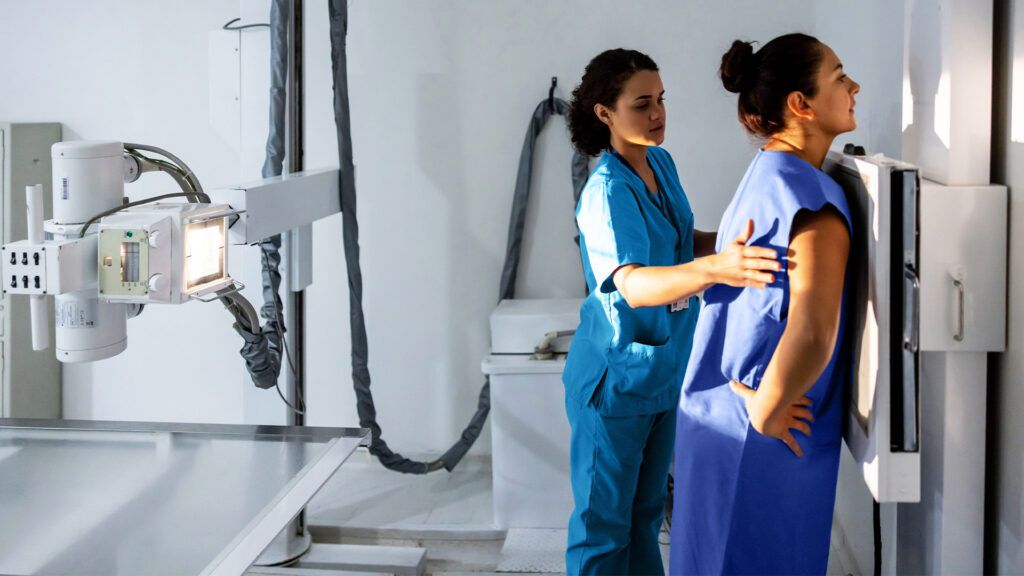X-rays can help doctors identify TB infections. They look for specific characteristics in these images to make a diagnosis.
TB is an infectious disease that primarily affects the lungs, although it can sometimes spread to other parts of the body. The condition is a significant public health concern with significant global effects. It affects
In some cases, TB can be life threatening. Because of its potentially serious nature, it is crucial to detect the disease early to prevent its spread and start timely treatment.
Early detection typically involves a medical evaluation, TB blood or skin tests, and chest X-rays. X-rays allow doctors to look for signs of TB in the lungs.
This article explores the role of X-rays in TB diagnosis and discusses the radiographic features that characterize this infection.

A chest X-ray may be the next step following initial consultation with a doctor. They can help determine whether a person has an active TB disease. The decision to send someone for an X-ray may derive from their symptoms, medical history, and risk factors for TB.
Doctors who suspect TB recommend a chest X-ray at a radiology center or hospital with X-ray facilities. The referral includes specific instructions and details about the imaging necessary.
Learn more about X-rays.
X-ray procedures are safe, usually with minimal radiation exposure. Still, pregnant people or individuals with certain medical conditions should inform the technician before the procedure.
The procedure is noninvasive and quick. The individual stands in front of the X-ray machine, often against a panel. A technician positions them correctly to ensure they capture a clear chest image. The individual must remain still for a few seconds while the machine takes an X-ray image.
After the X-ray, the individual can resume their everyday activities. The radiologist will analyze the images and send a report to the referring doctor, who will then discuss the results and next steps with the individual.
When doctors suspect a person has TB, they typically order an X-ray of the thorax, which is the area between the neck and the abdomen. They look for certain radiological features to help confirm their theories and guide treatment.
Characteristics of TB on X-ray include the below.
Infiltrates in the lung
TB often presents as infiltrates, which are areas of increased opacity in the lungs on chest X-rays.
These infiltrates are
Lung tissue damage or cavitation
One of the
These cavities are widespread in reactivation TB and are often observable in the upper lobes. Reactivation TB refers to a resurgence of the disease in a person who previously had a latent or controlled TB infection. A weakened immune system may be responsible for triggering TB reactivation.
Pleural effusion
TB can also
On a chest X-ray, pleural effusion appears as an area of equal opacity, typically at the lung base.
Pleural effusion in TB may also indicate a related pleural infection.
Lymphadenopathy
Enlarged lymph nodes, especially in the mediastinal region, can sometimes show up on X-rays of people with TB.
The mediastinal region of the lungs refers to the area in the chest that lies between the lungs, containing the heart, major blood vessels, windpipe (trachea), esophagus, and lymph nodes.
This is more commonly observable in children and can be an important diagnostic clue.
Miliary pattern
In some cases, TB can spread throughout the lungs, leading to a
This pattern resembles numerous small nodules scattered throughout both lungs, resembling millet seeds, hence the term miliary.
While chest X-rays are valuable in diagnosing TB, they
Additionally, other lung conditions can mimic the appearance of TB on an X-ray. Therefore, a diagnosis should not solely rely on imaging findings but should also include the following:
- clinical assessment
- sputum tests, which check for bacteria or other organisms in the lungs
- further imaging studies, if necessary
Doctors may find it challenging to differentiate TB from pneumonia on a chest X-ray. Both conditions can present similar features, such as lung infiltrates and effusions.
However, one key characteristic is that TB is more likely to show upper lobe infiltrates with cavitation. In contrast, bacterial pneumonia often presents with consolidated areas in the lung, typically in the lower lobes.
Additionally, a miliary pattern or lymphadenopathy is more suggestive of TB.
Chest X-rays are essential to the initial assessment and management of TB. They typically show characteristic features such as infiltrates, cavitation, pleural effusion, lymphadenopathy, and a miliary pattern, which can indicate TB infection. These radiographic findings can vary depending on the stage and severity of the disease.
Despite their importance in the diagnostic process, chest X-rays alone cannot provide a definitive diagnosis or exclusion of TB. Doctors typically use them in conjunction with other diagnostic methods to confirm the presence of TB bacteria.
Therefore, while chest X-rays are valuable, they form only part of the comprehensive diagnostic approach necessary for TB.
